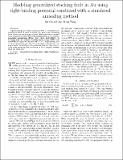| dc.contributor.author | Cai, Jun | |
| dc.contributor.author | Wang, Jian-Sheng | |
| dc.date.accessioned | 2003-12-23T02:39:37Z | |
| dc.date.available | 2003-12-23T02:39:37Z | |
| dc.date.issued | 2002-01 | |
| dc.identifier.uri | http://hdl.handle.net/1721.1/4005 | |
| dc.description.abstract | Tight-binding potential combined with a simulated annealing method is used to study the generalized stacking fault structure and energy of gold. The potential is chosen to fit band structures and total energies from a set of first-principles calculations (Phys. Rev. B54, 4519 (1996)). It is found that the relaxed stacking fault energy (SFE) and anti-SFE are equal to 46 and 102 mJ/m², respectively, and in good agreement with the first principles calculations and experiment. In addition, the potential predicts that the c/a of hcp-like stacking fault structure in Au is slightly smaller than the ideal one. | en |
| dc.description.sponsorship | Singapore-MIT Alliance (SMA) | en |
| dc.format.extent | 188138 bytes | |
| dc.format.mimetype | application/pdf | |
| dc.language.iso | en_US | |
| dc.relation.ispartofseries | High Performance Computation for Engineered Systems (HPCES); | |
| dc.subject | generalized stacking fault | en |
| dc.subject | tight-binding potential | en |
| dc.subject | Au | en |
| dc.title | Modeling generalized stacking fault in Au using tight-binding potential combined with a simulated annealing method | en |
| dc.type | Article | en |
